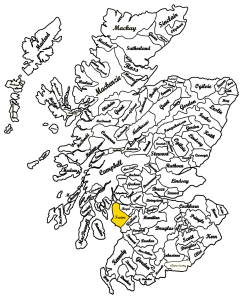 The origins of Clan Irvine can be traced back to Dumfriesshire, where the lands bearing the name Irvine first emerged. Family tradition asserts a connection to the early Celtic monarchs of Scotland, adding an air of mystique to their heritage. The origins of Clan Irvine can be traced back to Dumfriesshire, where the lands bearing the name Irvine first emerged. Family tradition asserts a connection to the early Celtic monarchs of Scotland, adding an air of mystique to their heritage.
One notable figure in Clan Irvine’s history is Gilchrist, son of Erwini, who witnessed a charter of the Lord of Galloway between 1124 and 1165. His presence in such important documentation signifies the family’s standing and influence during that era.
The Irvine family’s close proximity to the Bruces, whose seat was at Lochmaben near Bonshaw, fostered a bond between the two families. William de Irwin, a neighbor of the Bruces, not only supported his powerful neighbors but also rose in ranks to become armor bearer and later secretary to King Robert.
In recognition of his faithful service, William de Irwin was granted the royal forest of Drum in Aberdeenshire. This became the family’s chief seat and the foundation upon which the majestic Drum Castle was built. Initially a hunting lodge, the castle grew in grandeur over the centuries, remaining in the continuous occupation of the Irvine family until it was eventually entrusted to the National Trust for Scotland.
The Irvines were not only known for their ancestral connections but also for their remarkable contributions to Scottish history. The third Laird of Drum, Sir Alexander de Irwyne, was a knight of legendary prowess who distinguished himself in the French wars and fought in the Battle of Harlaw in 1411. It was during this battle that he engaged in a famous single combat with Maclean of Duart, resulting in both warriors perishing from their wounds.
The Lairds of Drum continued to leave their mark on Scotland’s history. They played significant roles in negotiations, battles, and political affairs. The tenth Laird, Alexander, stood as a staunch royalist and supporter of Charles I, while the fourteenth Laird fought as a Jacobite at the Battle of Sheriffmuir in 1715. Their unwavering loyalty to their causes and the land of Scotland shaped the destiny of Clan Irvine.
The Irvines also produced notable individuals outside the realm of war and politics. Colonel John Irvine of Bonshaw participated in the Abyssinian Campaign of 1867, and his son, Sir Robert Irvine of Bonshaw, served as the commodore of the Cunard Line and captain of the illustrious Queen Mary.
Through the ages, Clan Irvine endured triumphs and trials, always displaying resilience and unwavering dedication to their Scottish roots. Their legacy lives on, encapsulated in the breathtaking Drum Castle and the stories of their ancestors. |

